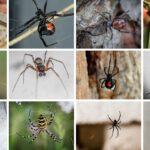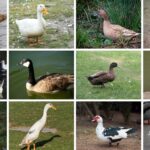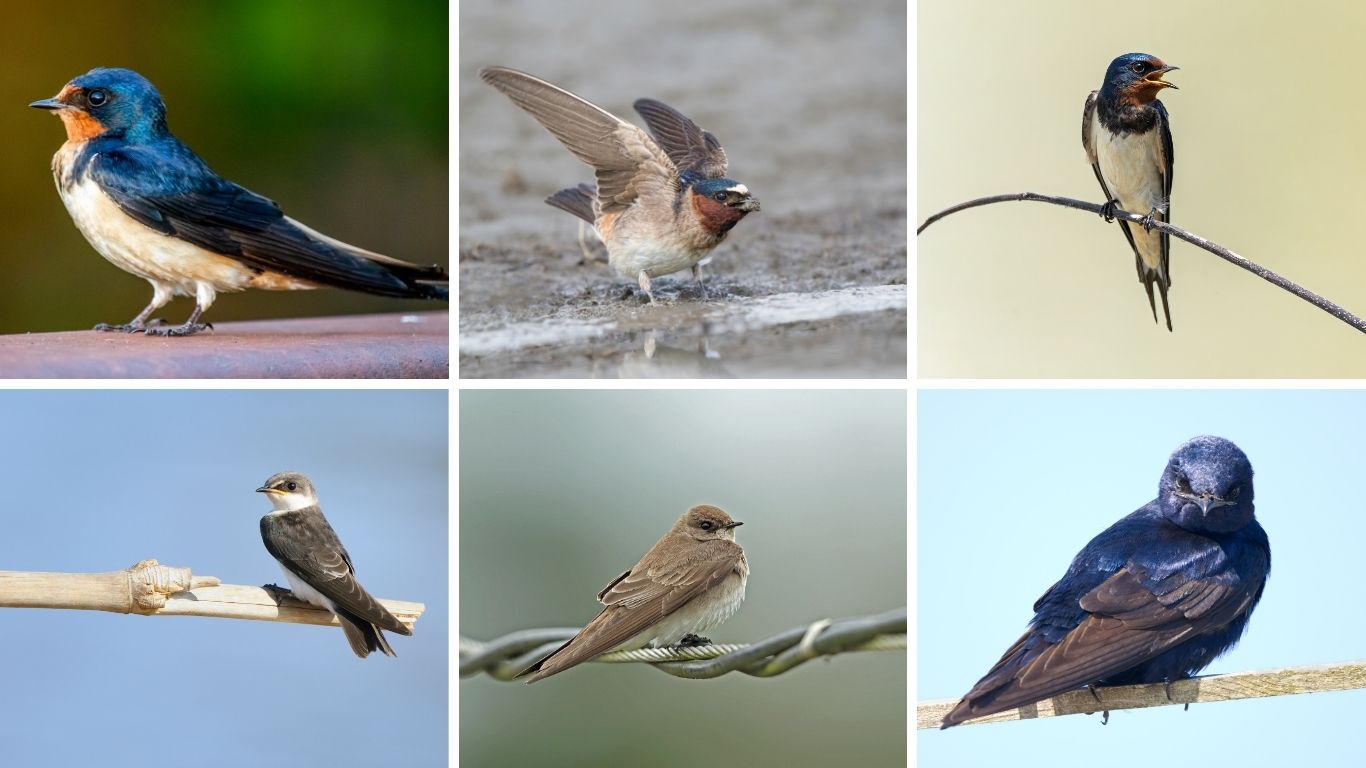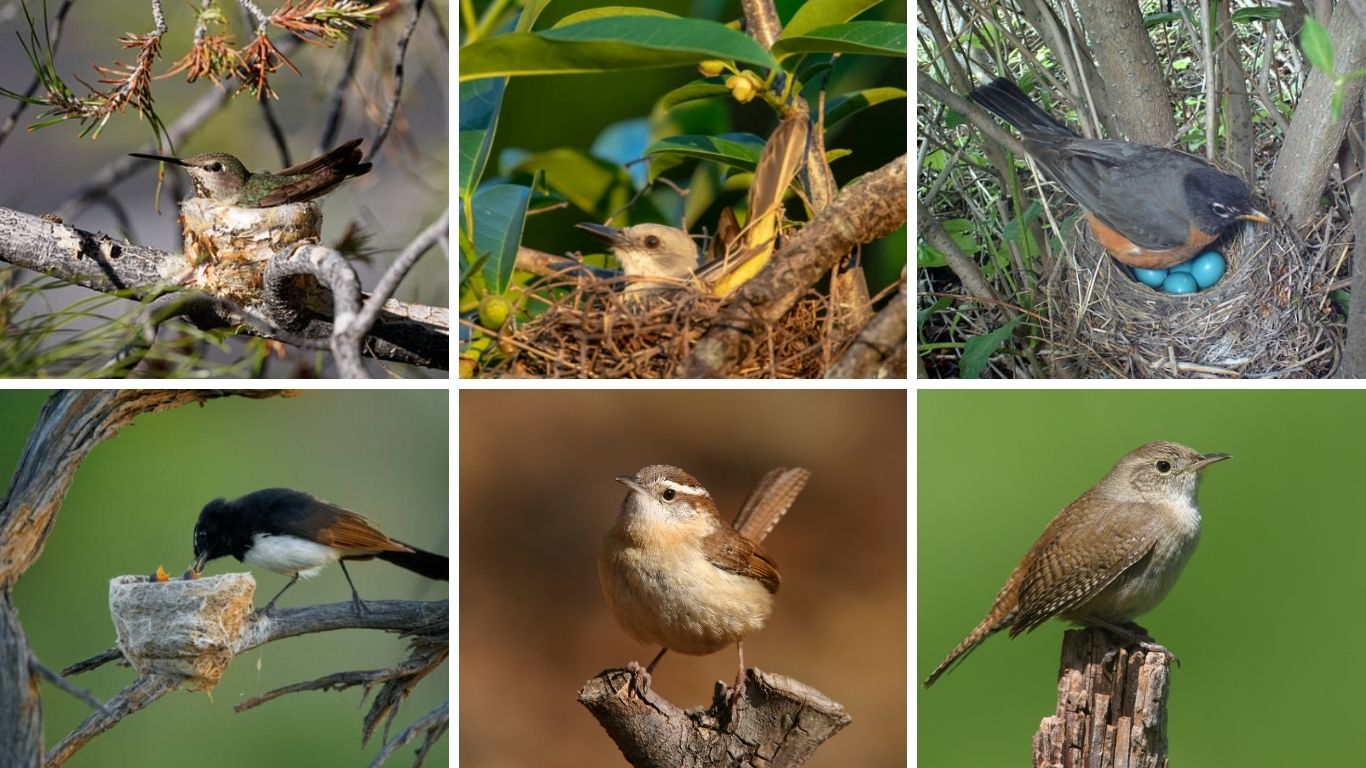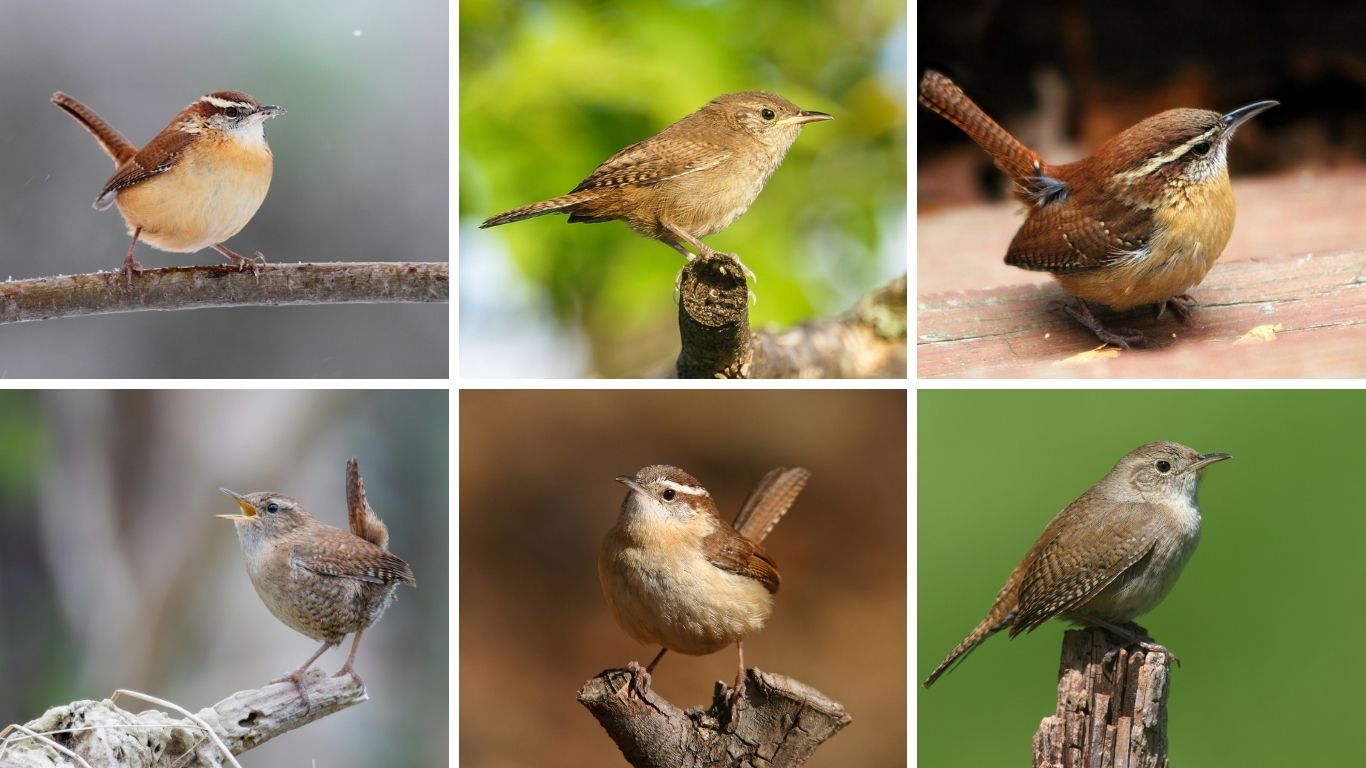Swallows are agile, insect-eating birds known for their sleek bodies, pointed wings, and graceful flight. Found on nearly every continent, these birds play a vital role in controlling insect populations and adapting to diverse habitats—from cliffs and riverbanks to cities and farms. This guide explores 30 different types of swallows from around the world, including their key features, natural behavior, and nesting patterns.
1. Barn Swallow (Hirundo rustica)

The Barn Swallow is the most widespread swallow species in the world. Instantly recognizable by its long forked tail and graceful flight, it thrives in both rural and urban areas. These birds are often seen darting over open fields and water bodies in pursuit of flying insects.
Identification and Appearance
- Deep blue back and wings
- Reddish forehead and throat
- Cream to buff underparts
- Long, deeply forked tail with white spots on the outer feathers
Habitat and Range
Barn Swallows breed across North America, Europe, Asia, and North Africa. They often build cup-shaped mud nests in barns, under bridges, or on buildings.
Behavior and Diet
These agile flyers feed almost entirely on flying insects. They hunt on the wing and prefer open areas. Barn Swallows are also known for their migratory behavior, traveling thousands of miles between breeding and wintering grounds.
Nesting and Breeding
They use mud and plant material to build nests, often returning to the same site each year. Both parents care for the young, and multiple broods may occur in one season.
2. Cliff Swallow (Petrochelidon pyrrhonota)
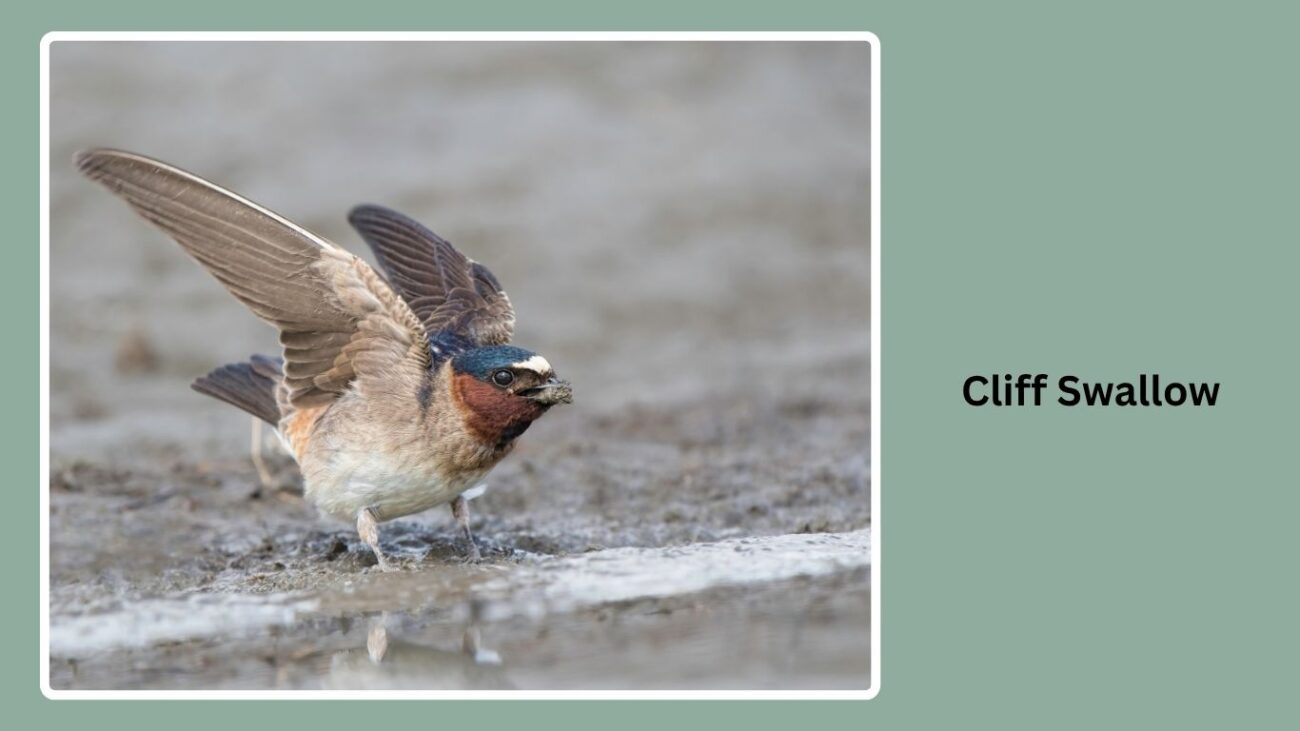
Cliff Swallows are known for their gourd-shaped mud nests and strong social behavior. These swallows often nest in large colonies on cliffs, bridges, and buildings. Their compact bodies and square tails distinguish them from other species.
Identification and Appearance
- Pale forehead patch
- Dark, metallic blue back
- Creamy to buff-colored underparts
- Short, squared tail
- Chestnut-colored rump and throat
Habitat and Range
Common throughout North America during breeding season, they prefer open areas near water and cliffs or manmade structures for nesting.
Behavior and Diet
Cliff Swallows are social birds, often seen flying in flocks while foraging for flying insects. They feed in open air and are especially active at dusk.
Nesting and Breeding
They construct enclosed mud nests with small entrance holes. Nest colonies can number in the hundreds, and birds often reuse or repair old nests year after year.
3. Tree Swallow (Tachycineta bicolor)
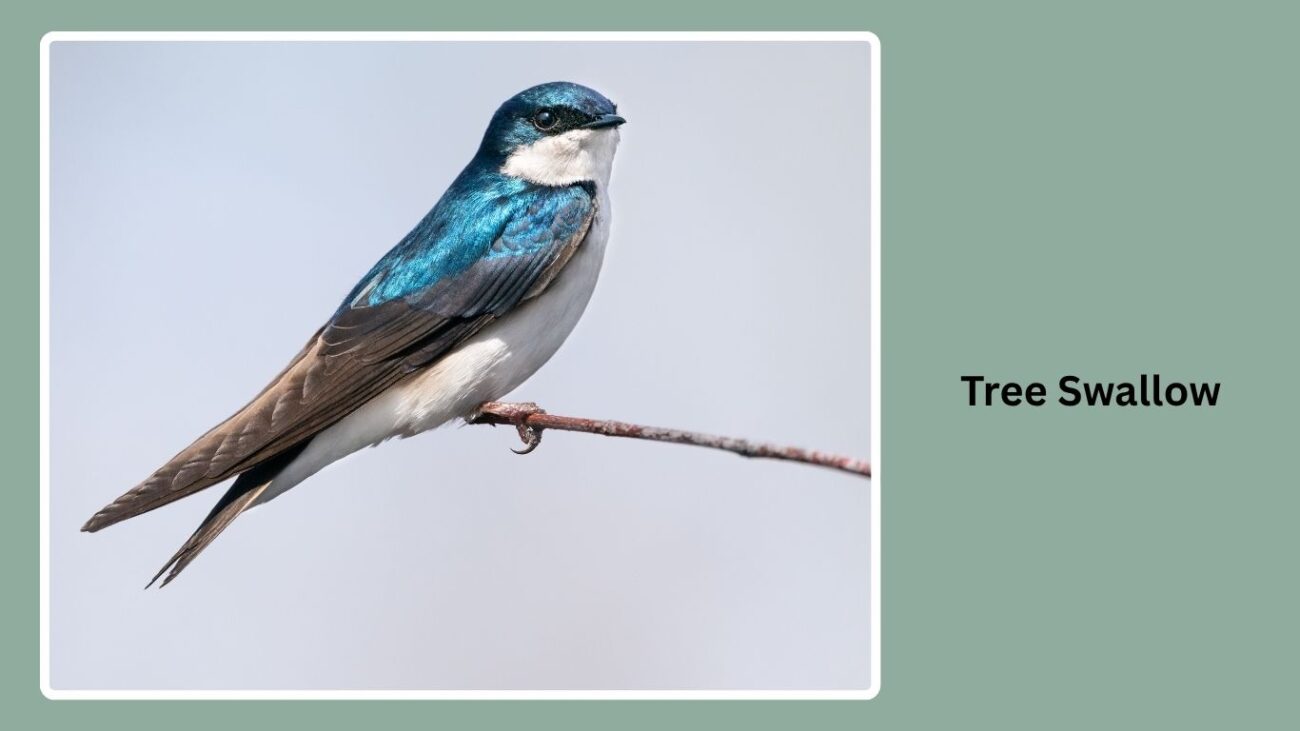
Tree Swallows are sleek and elegant birds with shimmering blue feathers. They’re often seen flying low over fields or water, catching insects in mid-air. Unlike some swallows, they readily use nest boxes in addition to natural cavities.
Identification and Appearance
- Iridescent blue-green back
- Clean white underparts
- Small, notched tail
- Blackish wings
Habitat and Range
Found across most of North America, they prefer wetlands, open fields, and forest edges, especially near water bodies.
Behavior and Diet
Tree Swallows mainly eat flying insects but will also consume berries, especially in cooler weather when insects are scarce. They are agile flyers and often forage in small groups.
Nesting and Breeding
They nest in tree cavities or nest boxes, lining the nests with feathers. Pairs may return to the same site each year, and both parents participate in raising the young.
4. Bank Swallow (Riparia riparia)
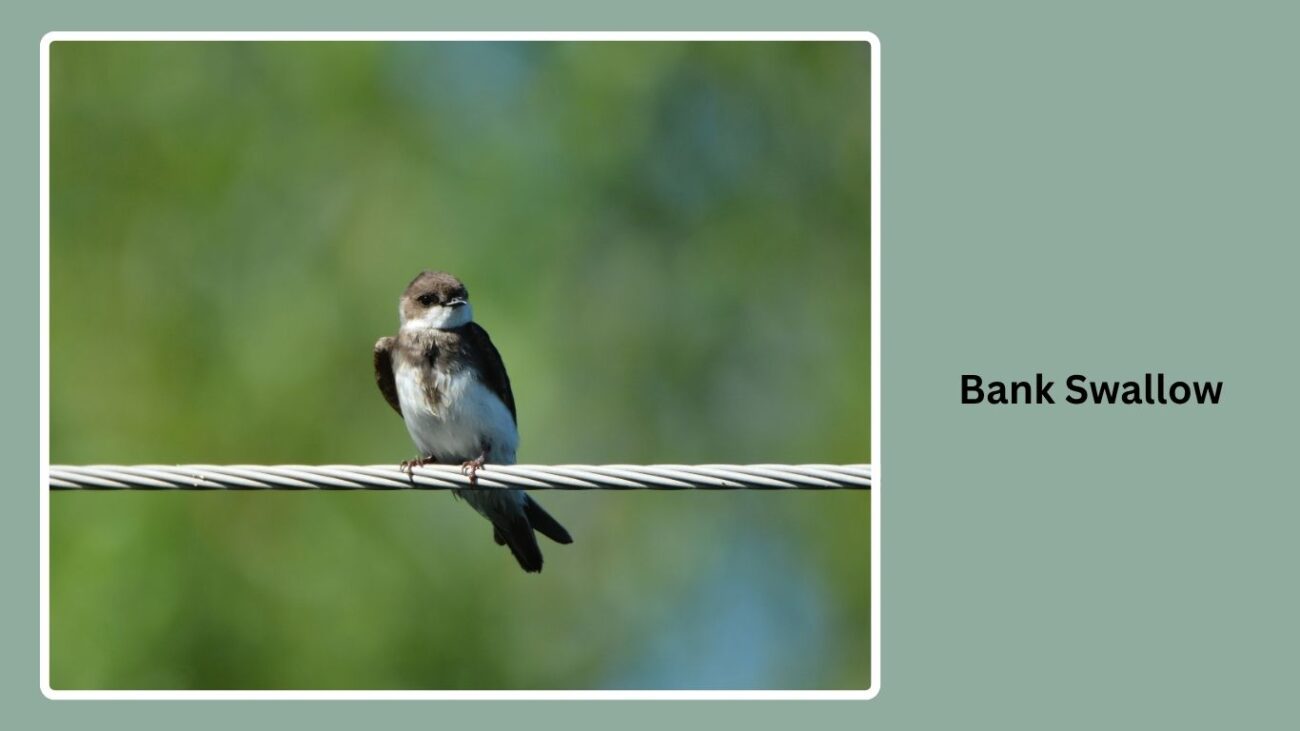
The Bank Swallow is the smallest swallow species in North America. It gets its name from its nesting preference—vertical banks of rivers, sandpits, and gravel quarries. These birds form dense colonies and are always in motion.
Identification and Appearance
- Brown upperparts
- White underparts with a distinct brown chest band
- Small body with a slender build
- Short, slightly forked tail
Habitat and Range
They breed throughout North America, Europe, and Asia, favoring areas near water with vertical earthen banks for nesting.
Behavior and Diet
Bank Swallows are fast, agile flyers, feeding on small flying insects over fields, water, and open terrain. They are very social and often seen in flocks during migration.
Nesting and Breeding
They dig horizontal burrows into sandy or muddy banks, creating nest chambers at the end. Colonies can number in the hundreds. Nesting occurs in close proximity with intense social activity.
5. Northern Rough-winged Swallow
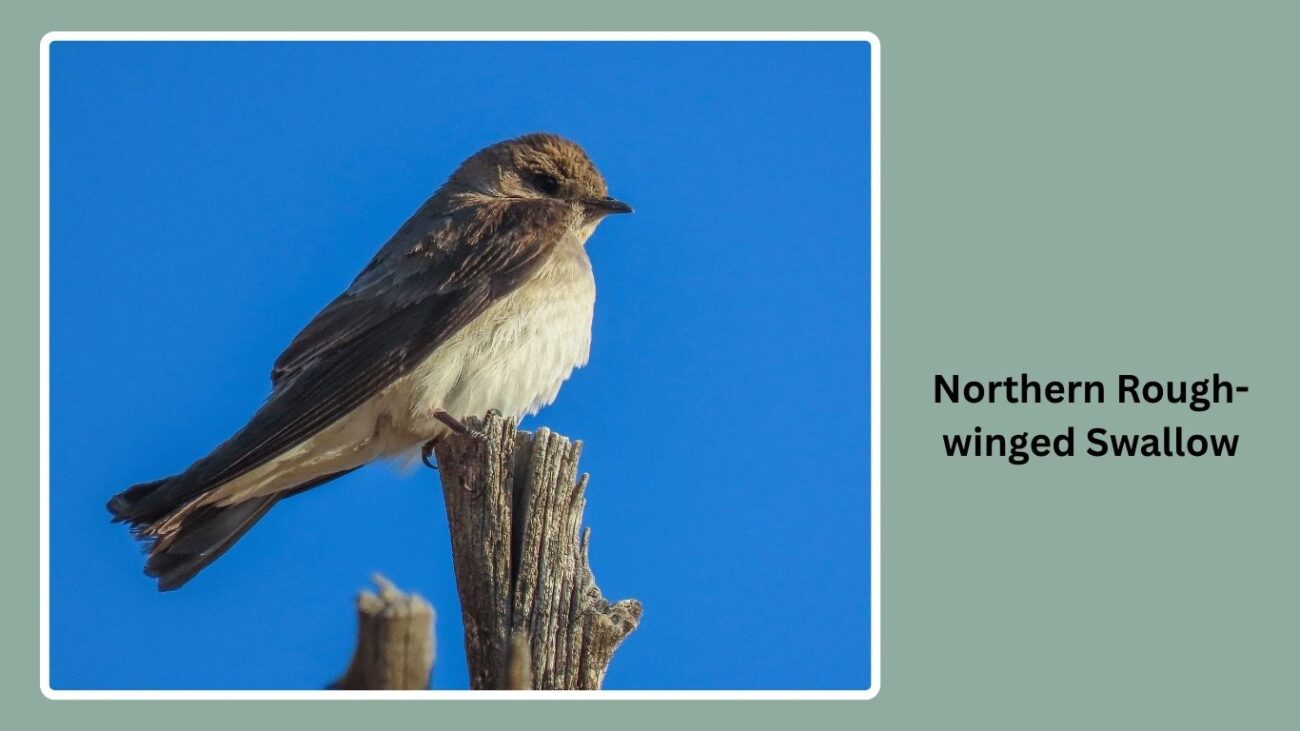
This quiet and solitary species is named for the tiny hooks or “rough” edges on its outer wing feathers. Northern Rough-winged Swallows are less flashy than other swallows but are skilled aerial insect hunters.
Identification and Appearance
- Dull brown upperparts
- Pale brownish-white underparts
- Small size with short, notched tail
- No sharp contrast between throat and chest
Habitat and Range
Widespread in North and Central America, often found near streams, lakes, and quarries. They prefer low-traffic areas for nesting.
Behavior and Diet
They fly low over water or open ground, capturing insects in flight. Unlike many swallows, they’re often seen alone or in small groups rather than large colonies.
Nesting and Breeding
They nest in burrows in banks, crevices, or pipes. The nesting sites are usually solitary or in very loose colonies. Both parents help rear the young.
6. Purple Martin (Progne subis)

Purple Martins are the largest swallow species in North America and are famous for their shimmering dark feathers and musical calls. They depend heavily on man-made nest boxes, especially in the eastern U.S.
Identification and Appearance
- Males: Iridescent dark blue-purple all over
- Females: Lighter belly with grayish throat and breast
- Long, tapered wings
- Short, slightly forked tail
Habitat and Range
They breed across much of the U.S., especially in open areas near water. In eastern regions, they rely on multi-compartment nest houses provided by humans.
Behavior and Diet
Highly social, they gather in large flocks and perform swift, acrobatic flights to catch flying insects. They may fly higher than other swallows when feeding.
Nesting and Breeding
In the East, they nest almost exclusively in birdhouses or gourds; in the West, they may still nest in tree cavities. Males arrive first in spring to claim and defend nest sites.
7. Cave Swallow (Petrochelidon fulva)
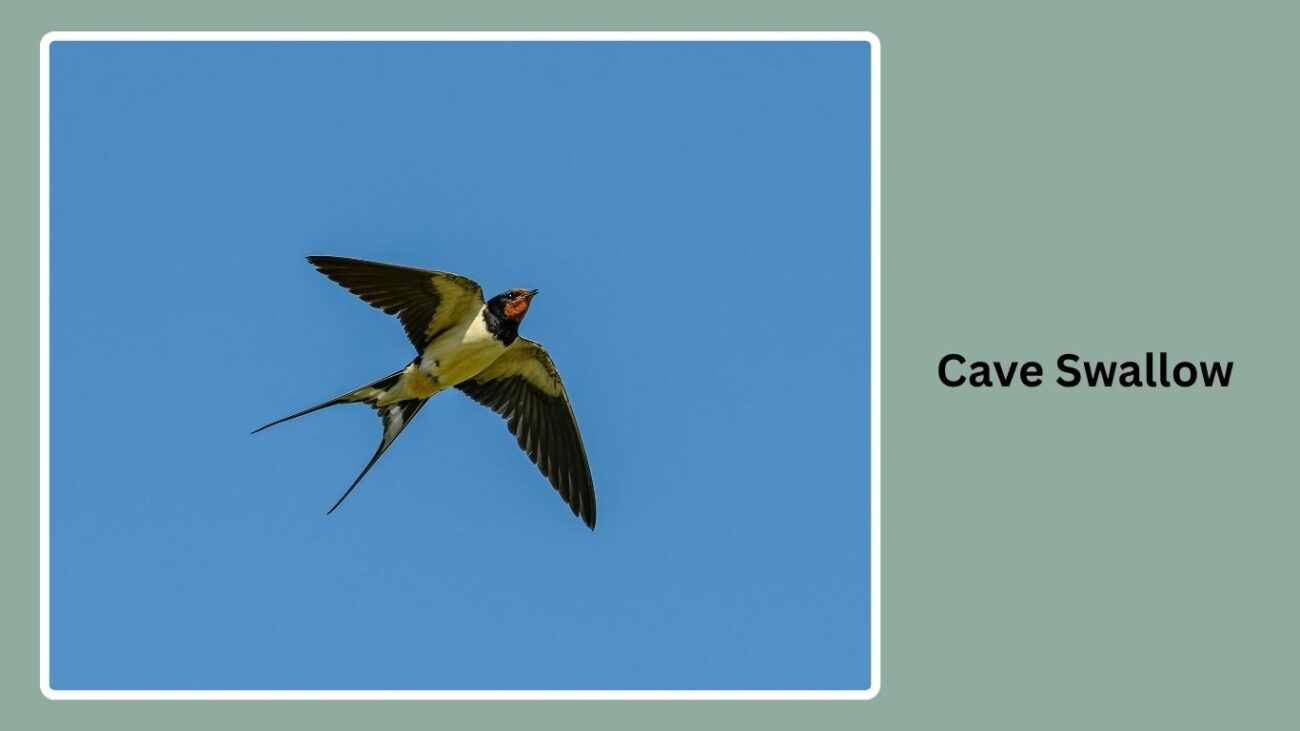
Cave Swallows are colonial birds that originally nested in caves and sinkholes, but now often use bridges and culverts. They’re especially common in the southern U.S., Mexico, and the Caribbean.
Identification and Appearance
- Pale forehead
- Rusty throat and rump
- Blue-black upperparts
- Creamy underparts
- Short, square tail
Habitat and Range
Found in Texas, Florida, Mexico, and parts of Central America. Their preferred habitats include coastal areas, deserts, and areas near limestone caves or manmade structures.
Behavior and Diet
Cave Swallows fly gracefully as they hunt insects mid-air. They are often seen foraging in groups and may mix with other swallow species.
Nesting and Breeding
They build gourd-shaped mud nests in protected areas like cave walls or highway overpasses. Colonies can be large, and nests are typically close together.
8. Violet-green Swallow (Tachycineta thalassina)
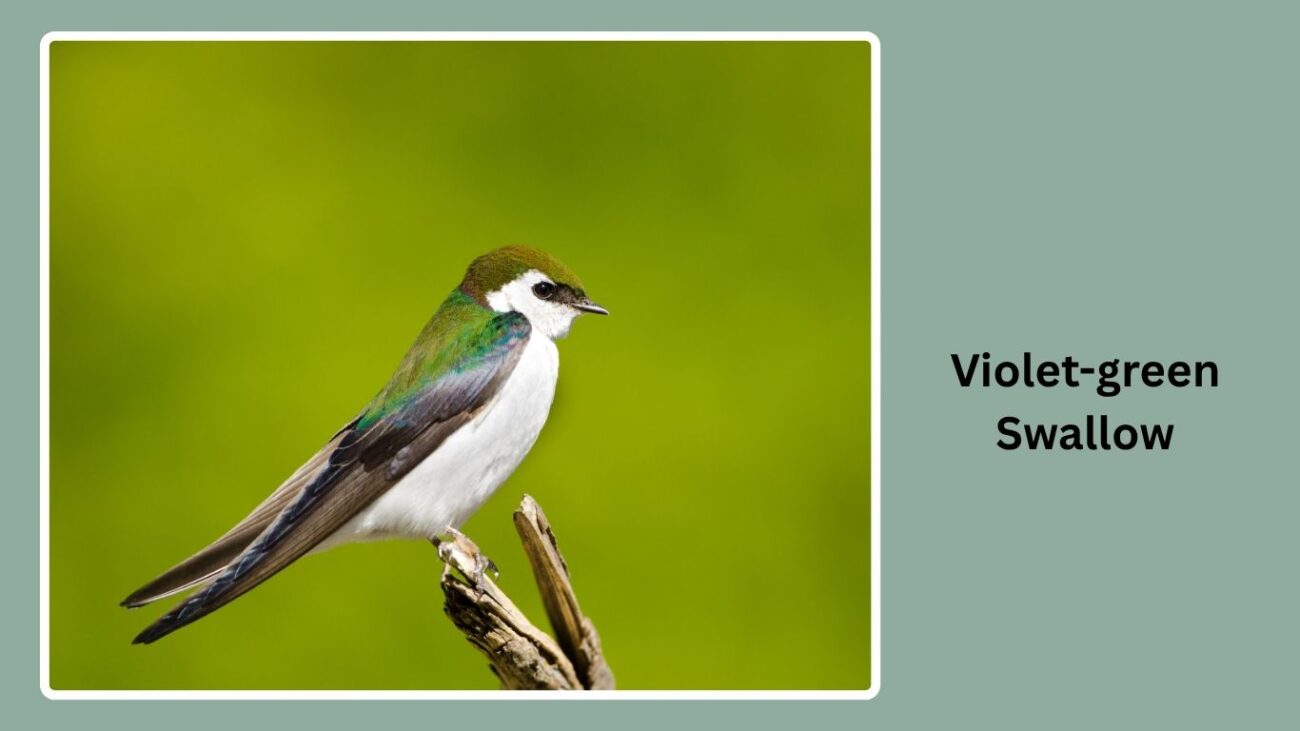
The Violet-green Swallow is a striking species of the western Americas, known for its glossy green back and violet rump. These birds are often seen gliding effortlessly over open woodlands and mountainous regions.
Identification and Appearance
- Iridescent green upperparts with violet on the rump
- White underparts
- White extends behind and above the eyes
- Short, slightly notched tail
Habitat and Range
Common in western North America, particularly near forests, cliffs, and canyons. They prefer nesting sites near open areas for foraging.
Behavior and Diet
They feed mid-air on flying insects, often in small flocks. Violet-green Swallows are especially active in early morning and late afternoon.
Nesting and Breeding
They nest in natural tree cavities, cliffs, and nest boxes. The female lines the nest with feathers, and both parents care for the young.
9. Mangrove Swallow (Tachycineta albilinea)

The Mangrove Swallow is a small and coastal species found mainly in Central America. It’s known for its affinity to water and shoreline habitats, where it can be seen skimming over the surface.
Identification and Appearance
- Shiny blue-green back
- White underparts
- Distinct white stripe running from the beak to behind the eye
- Small and compact with a short tail
Habitat and Range
Occurs along coasts, rivers, and lakes from Mexico to Panama. Especially common in mangrove forests and estuaries.
Behavior and Diet
Mangrove Swallows are quick, agile flyers that hunt insects over water. They usually forage alone or in pairs, sometimes with other swallows.
Nesting and Breeding
They nest in tree cavities, holes in dead trees, or even artificial structures near water. Nests are often lined with feathers and plant matter.
10. White-winged Swallow (Tachycineta albiventer)
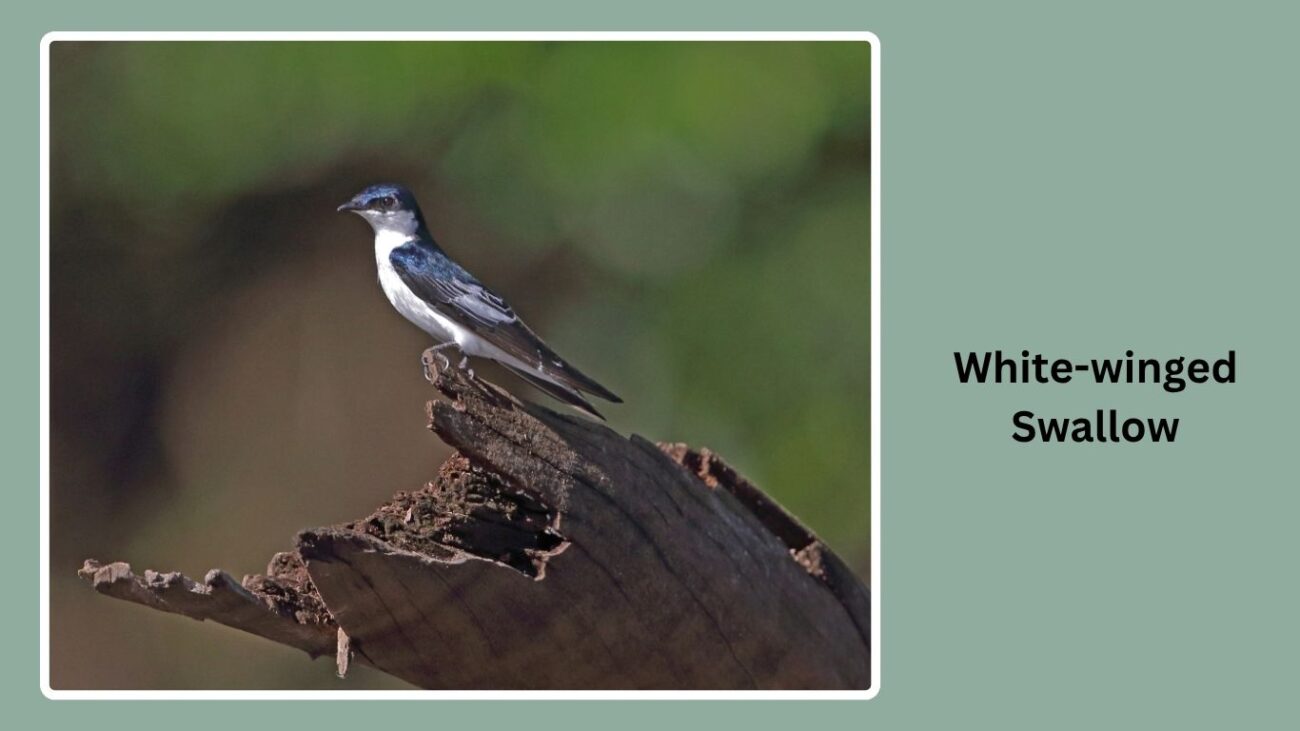
The White-winged Swallow is a beautiful bird of South America, easily recognized by the bold white patches on its wings. It thrives near freshwater environments like rivers and lakes.
Identification and Appearance
- Glossy blue-green upperparts
- White underparts
- Distinct white wing patches visible in flight
- Short, slightly forked tail
Habitat and Range
Found throughout northern and central South America, especially along rivers, lakeshores, and wetland margins.
Behavior and Diet
They hunt flying insects over water and open areas, often flying low and fast. These swallows may form small groups while foraging and are known for their acrobatic flight.
Nesting and Breeding
They nest in burrows, tree cavities, or crevices in riverbanks. Nests are lined with feathers and soft material. Pairs are territorial during the breeding season.
11. Southern Rough-winged Swallow (Stelgidopteryx ruficollis)

The Southern Rough-winged Swallow is a close relative of the Northern Rough-winged Swallow but lives in Central and South America. It’s a plain, unassuming bird that favors quiet, watery areas.
Identification and Appearance
- Light brown upperparts
- Pale, creamy underparts
- Slightly rufous (reddish) throat
- Short tail and plain facial features
Habitat and Range
Common throughout Central and South America, especially near rivers, lakes, and agricultural fields with exposed banks.
Behavior and Diet
They feed on small flying insects caught in midair. Unlike more social swallows, they are usually seen alone or in small groups.
Nesting and Breeding
Nesting occurs in burrows or cavities along riverbanks, sometimes using crevices in manmade structures. Nests are built with grasses and feathers, and the birds may reuse sites in later years.
12. Blue-and-white Swallow (Pygochelidon cyanoleuca)

The Blue-and-white Swallow is a common sight across much of South America. True to its name, this species features a crisp blue and white color pattern that makes it easy to recognize in flight.
Identification and Appearance
- Shiny blue upperparts
- Bright white underparts and face
- Small body with a short, slightly forked tail
- Clean, sharp contrast between blue and white
Habitat and Range
Found in open areas across Central and South America, from forests and farmlands to cities and towns. Often seen near water and human structures.
Behavior and Diet
They catch insects midair with rapid, darting flights. These swallows are highly adaptable and frequently seen flying low over open ground or water surfaces.
Nesting and Breeding
They nest in cavities, wall crevices, and buildings. Nests are made of plant fibers and feathers, and pairs may reuse the same site for multiple seasons.
13. Welcome Swallow (Hirundo neoxena)
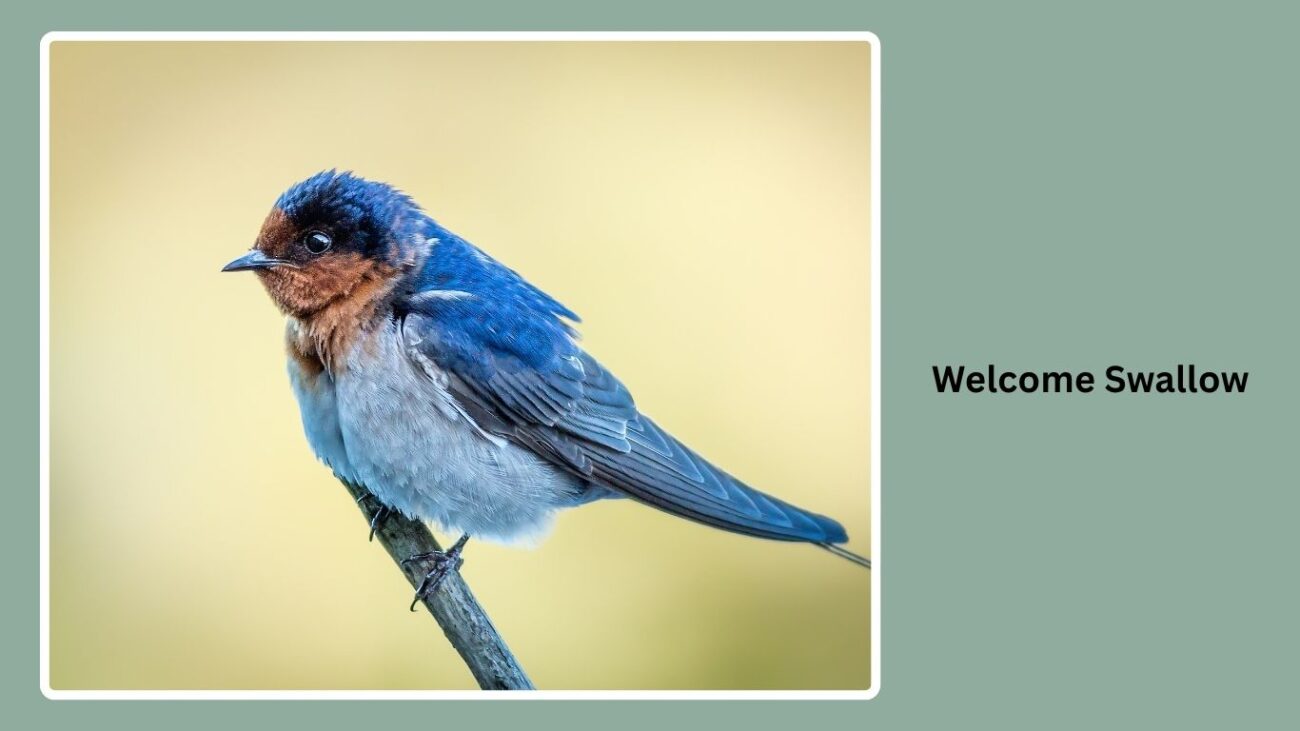
Native to Australia and parts of Oceania, the Welcome Swallow is named for its graceful flight and presence near human dwellings. It’s a familiar species often seen gliding over fields and roads.
Identification and Appearance
- Glossy blue-black back
- Rusty-red face and throat
- Pale underparts
- Long, deeply forked tail
Habitat and Range
Common across Australia, New Zealand, and nearby islands. Found in both urban and rural areas, especially near water and open spaces.
Behavior and Diet
Welcome Swallows are fast and agile insect hunters. They fly close to the ground or water, catching insects on the wing. They are also very sociable and often seen in groups.
Nesting and Breeding
They build mud nests under eaves, bridges, and rock ledges. Nests are lined with feathers and hair. These swallows often return to the same nesting sites each year.
14. Red-rumped Swallow (Cecropis daurica)
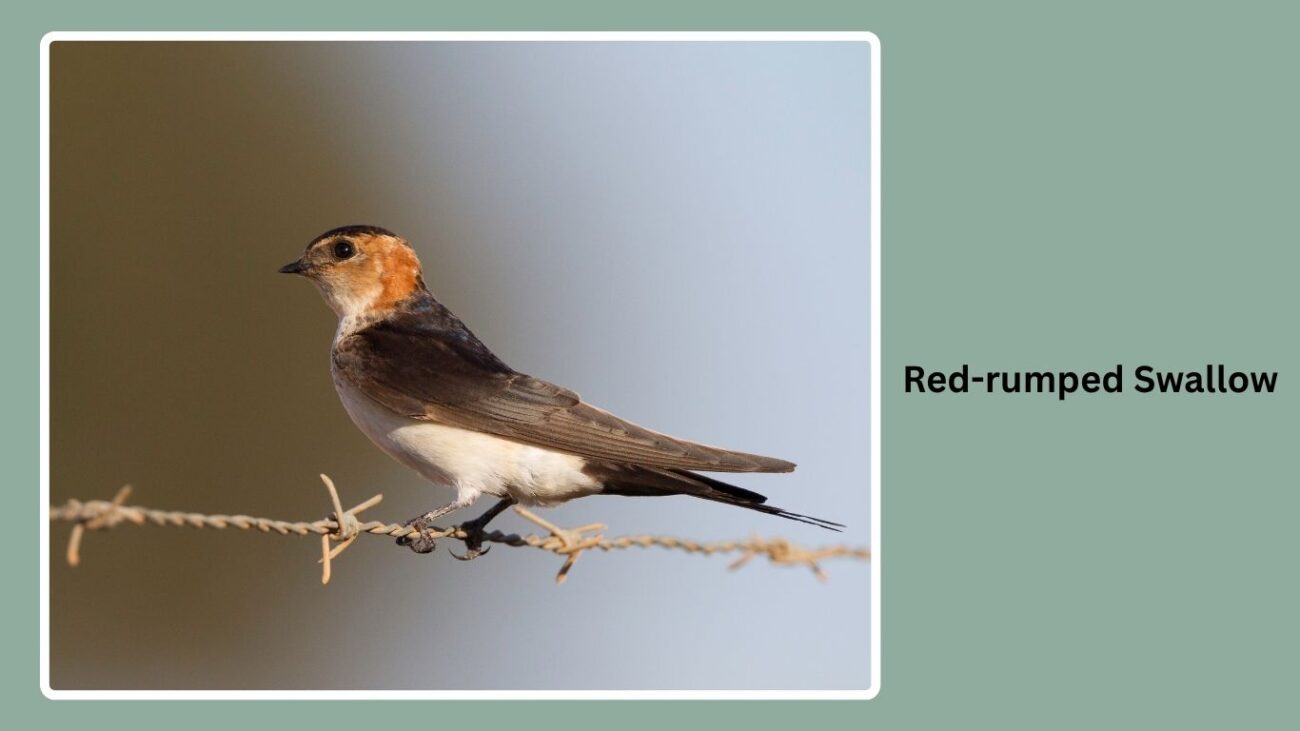
The Red-rumped Swallow is a graceful bird with a rusty-red rump and long tail streamers. It is often found in open countryside and is known for building mud nests under cliffs and man-made structures.
Identification and Appearance
- Glossy blue-black upperparts
- Pale underparts with fine dark streaks
- Reddish rump and nape
- Long, deeply forked tail
Habitat and Range
Found across southern Europe, North Africa, and much of Asia. Prefers open fields, hillsides, and areas near cliffs or buildings.
Behavior and Diet
Feeds mostly on flying insects, captured during swift, low-level flights over fields and water. They often forage in pairs or small groups.
Nesting and Breeding
They construct bottle-shaped mud nests with long entrance tunnels, typically under eaves, cliffs, or bridges. Pairs may reuse or repair old nests each year.
15. Wire-tailed Swallow (Hirundo smithii)
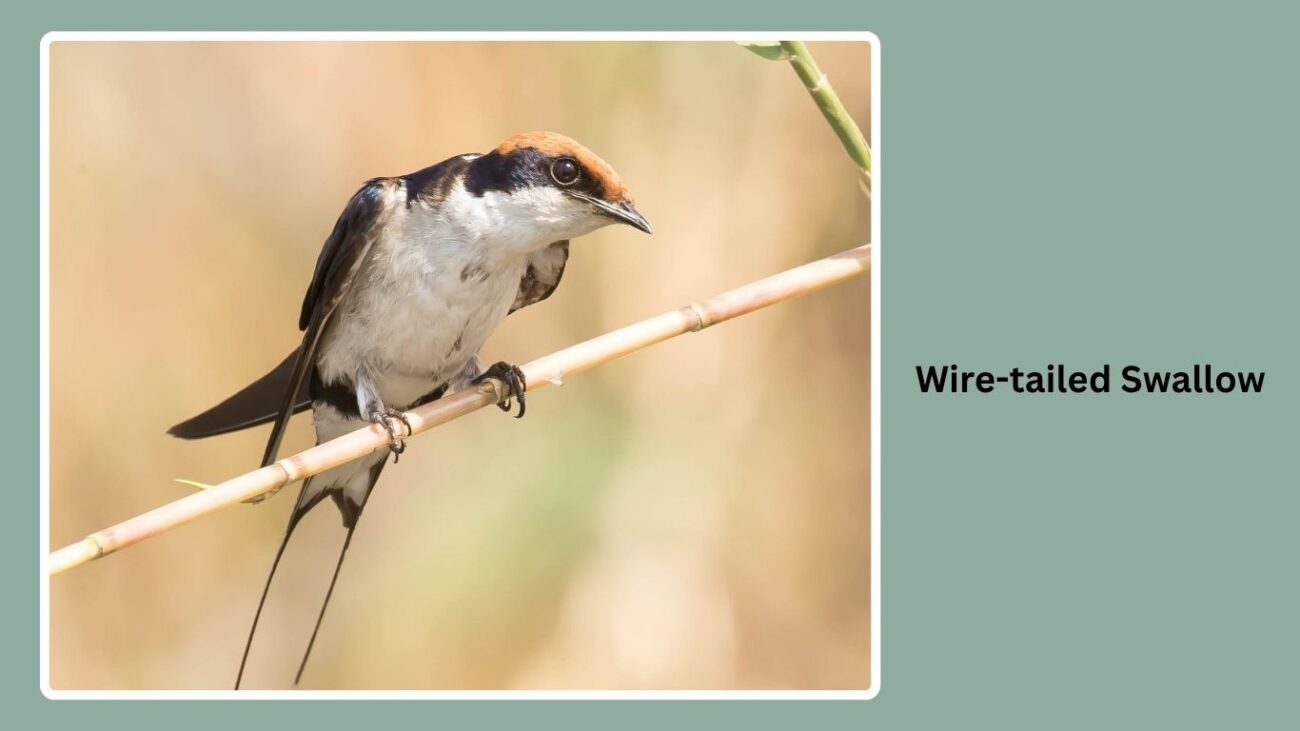
The Wire-tailed Swallow is a striking bird of Africa and South Asia, named for its distinctive long outer tail feathers that resemble thin wires.
Identification and Appearance
- Shiny blue upperparts
- White underparts
- Chestnut crown
- Two long wire-like tail streamers
Habitat and Range
Widespread in sub-Saharan Africa and parts of South Asia. Often found near water, open fields, and human settlements.
Behavior and Diet
Wire-tailed Swallows are solitary or live in pairs. They feed on insects in the air, performing quick and elegant flights over rivers, lakes, and fields.
Nesting and Breeding
They build mud nests attached to vertical surfaces, often on bridges, culverts, or buildings. Nests are small, cup-shaped, and lined with soft material.
16. Pacific Swallow (Hirundo tahitica)
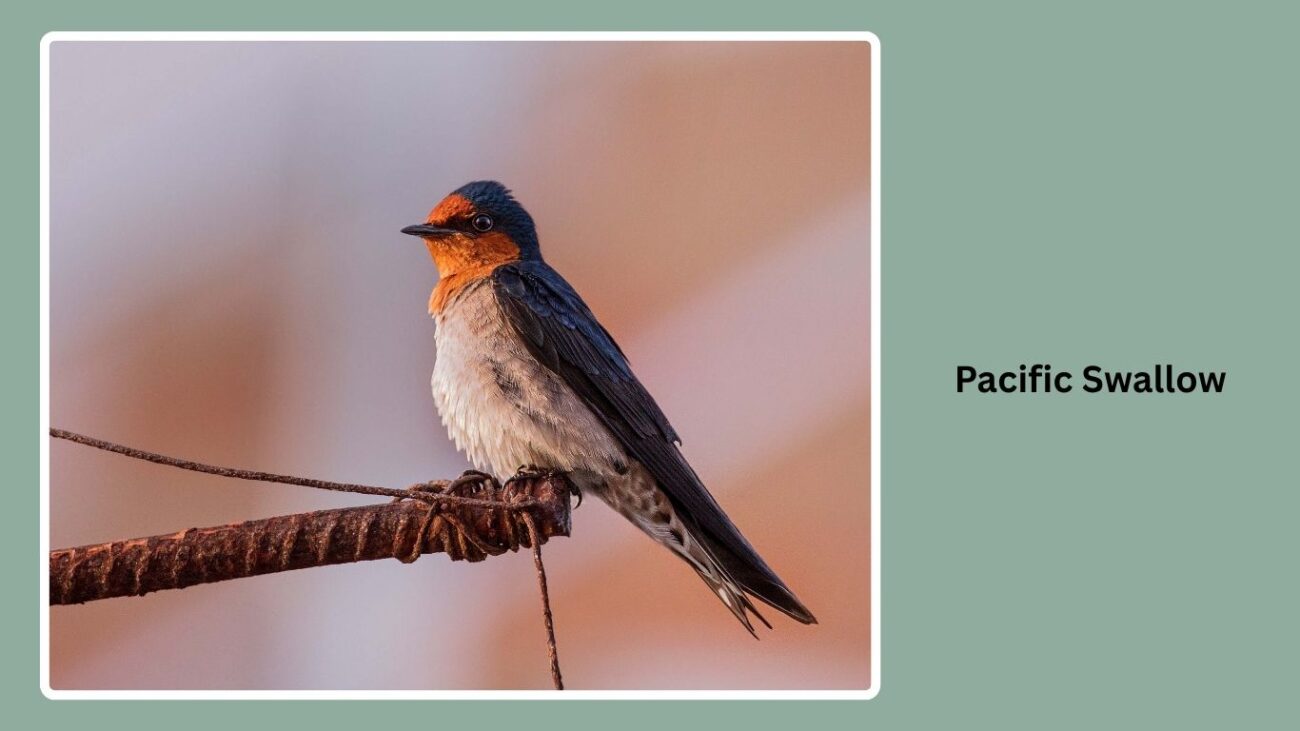
The Pacific Swallow is a compact and widespread swallow found throughout Southeast Asia and many Pacific islands. It closely resembles the Barn Swallow but lacks long tail streamers.
Identification and Appearance
- Glossy blue-black upperparts
- Rusty-red forehead and throat
- Creamy to rufous underparts
- Short, slightly forked tail (no long streamers)
Habitat and Range
Occurs from Southeast Asia to Polynesia and northern Australia. Commonly seen around coastal areas, villages, and forest edges.
Behavior and Diet
They hunt flying insects over open spaces, water, and near human habitation. Their flight is swift and erratic, and they are often seen gliding low.
Nesting and Breeding
They build mud nests on vertical surfaces like cliffs, walls, or beams. The nests are lined with feathers, and pairs often reuse the same nest in successive years.
17. House Martin (Delichon urbicum)
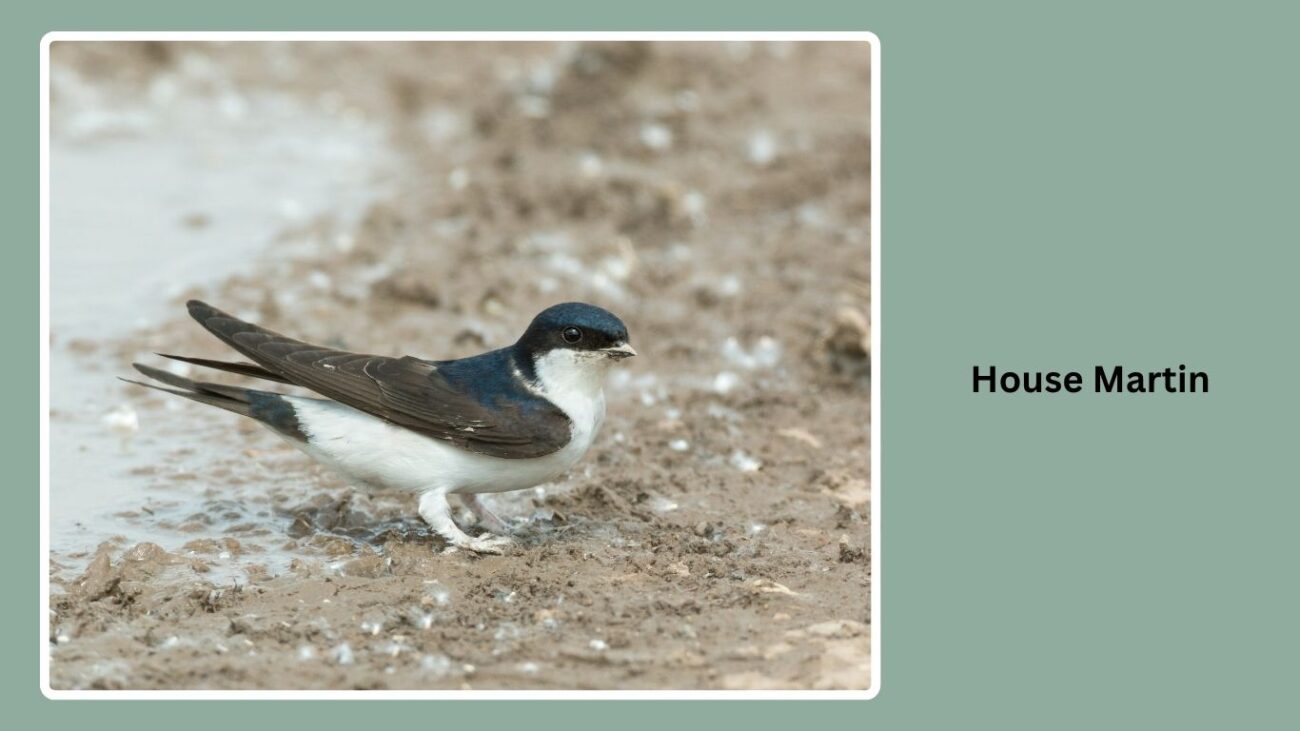
The House Martin is a familiar species in Europe and parts of Asia, often nesting under the eaves of buildings. It is known for its white rump and social nesting habits.
Identification and Appearance
- Glossy blue-black upperparts
- White rump and underparts
- Short, forked tail
- Compact body with a clean white face
Habitat and Range
Widespread across Europe, North Africa, and parts of Asia. Prefers towns, villages, and open countryside with access to mud for nest building.
Behavior and Diet
Feeds on small flying insects, especially flies and aphids. House Martins are strong fliers and forage high in the air, often in flocks.
Nesting and Breeding
They construct mud nests under roof eaves, forming colonies. Nests are enclosed with a small entrance hole. Multiple broods are common in a single season.
18. Asian House Martin (Delichon dasypus)

The Asian House Martin is a high-flying swallow found in parts of East and Southeast Asia. Similar in appearance to the European House Martin, it’s often seen soaring in mountainous or hilly regions.
Identification and Appearance
- Dark bluish-black upperparts
- White underparts and rump
- Slightly forked tail
- More heavily feathered legs than other martins
Habitat and Range
Breeds in mountainous regions across China, Japan, Korea, and the Himalayas. Winters in Southeast Asia and the Indian subcontinent.
Behavior and Diet
Feeds on flying insects caught high in the air. These martins are agile flyers, often seen circling steep terrain or buildings.
Nesting and Breeding
They nest in small colonies, often on cliffs or buildings. Nests are made of mud and lined with grass and feathers, usually with a small entrance hole.
19. Common House Martin (Delichon urbicum)
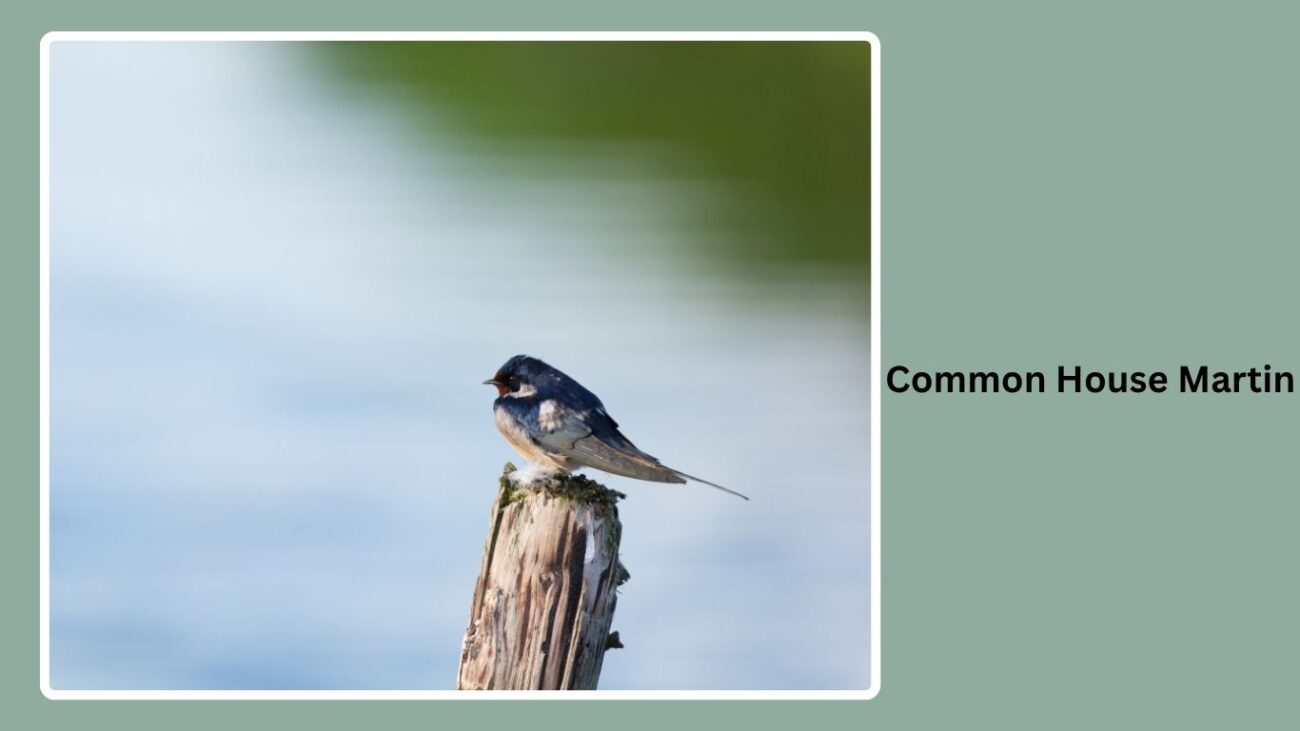
The Common House Martin is sometimes used interchangeably with the term “House Martin,” especially in Europe. It’s one of the most recognized urban swallows, frequently nesting on buildings.
Identification and Appearance
- Shiny blue-black upperparts
- Bright white underparts and rump
- Short, slightly forked tail
- Broad wings and small bill
Habitat and Range
Found throughout Europe, parts of Asia, and North Africa. Prefers urban and suburban settings with access to open skies and mud for nests.
Behavior and Diet
They feed exclusively on airborne insects, catching them in flight. House Martins are sociable birds, often forming large foraging flocks.
Nesting and Breeding
They build dome-shaped mud nests under eaves and overhangs. Colonies can consist of dozens of nests, with pairs often returning to the same location annually.
20. White-throated Swallow (Hirundo albigularis)
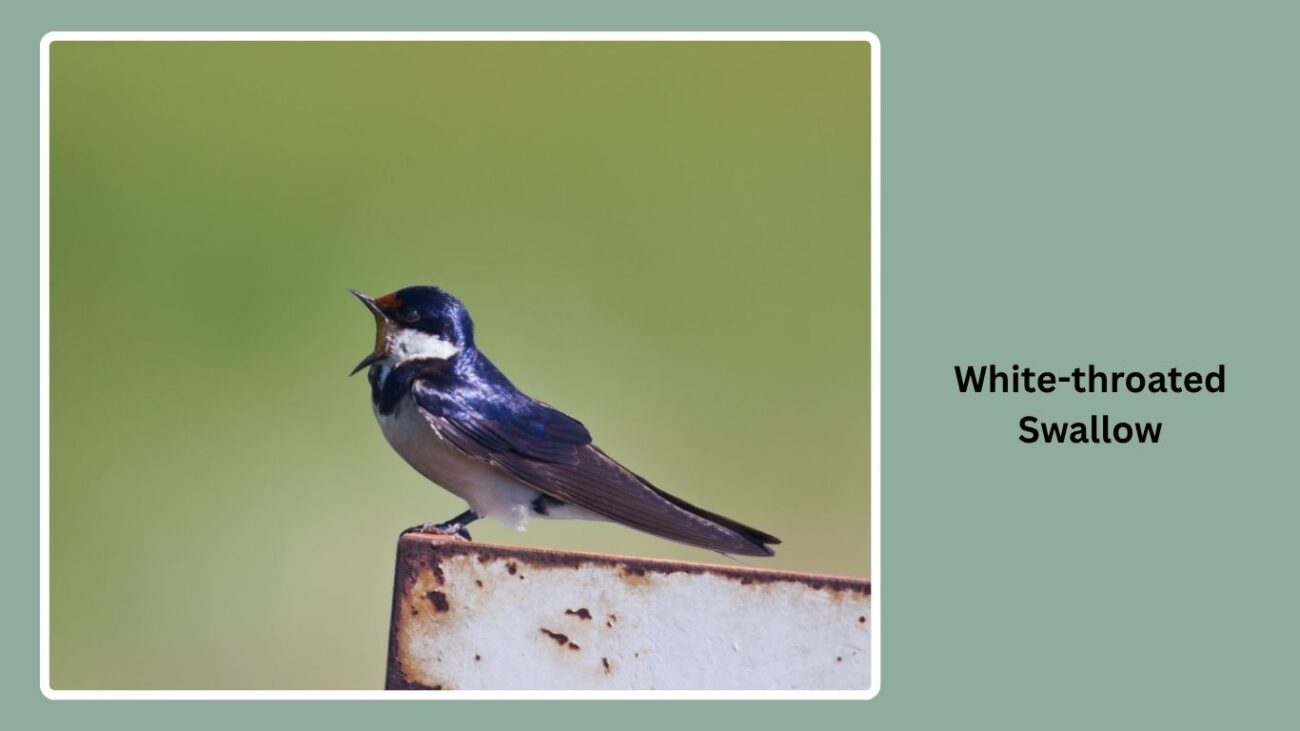
The White-throated Swallow is a graceful African species known for its striking color contrasts and elegant flight. It is often seen near water, especially around rivers and dams.
Identification and Appearance
- Glossy blue-black upperparts
- Bright white throat and belly
- Rich chestnut crown and nape
- Long, deeply forked tail
Habitat and Range
Commonly found in southern Africa, particularly near water bodies, open grasslands, and agricultural areas.
Behavior and Diet
Feeds mainly on flying insects captured in flight. It frequently skims low over water surfaces or fields, making quick, agile turns.
Nesting and Breeding
Builds cup-shaped mud nests often placed on ledges, under bridges, or on buildings. Both parents participate in nest construction and chick rearing.
21. Angola Swallow (Hirundo angolensis)

The Angola Swallow is a lesser-known species native to parts of central and southern Africa. It closely resembles the Barn Swallow but is distinguished by its shorter tail streamers and more uniform coloration.
Identification and Appearance
- Glossy blue back and wings
- Rufous forehead and throat
- Buff to rufous underparts
- Shorter tail streamers than Barn Swallow
Habitat and Range
Found across Angola, Zambia, and nearby regions. Prefers open countryside, farmland, and areas near water or human settlements.
Behavior and Diet
They are insectivorous and feed while flying, often alone or in small groups. Their flight is quick, with frequent glides and turns.
Nesting and Breeding
Nests are constructed from mud and lined with feathers, typically built under roofs or eaves of buildings. They may nest solitarily or in loose colonies.
22. Striated Swallow (Cecropis striolata)

The Striated Swallow is a beautifully patterned species found across South and Southeast Asia. It’s known for its bold streaking and earthy tones, and it often nests on buildings, cliffs, and other vertical structures.
Identification and Appearance
- Reddish forehead and throat
- Glossy blue-black back
- Buff to rufous underparts with dark streaks
- Long, forked tail
Habitat and Range
Widespread across India, Southeast Asia, southern China, and Indonesia. Found in open countryside, forest edges, and even urban areas.
Behavior and Diet
Feeds on flying insects, often seen gliding smoothly or swooping low over open fields. Usually forages alone or in pairs.
Nesting and Breeding
They build bottle-shaped mud nests on vertical surfaces. Nests are often reused, and breeding pairs may return to the same site each year.
23. Lesser Striped Swallow (Cecropis abyssinica)
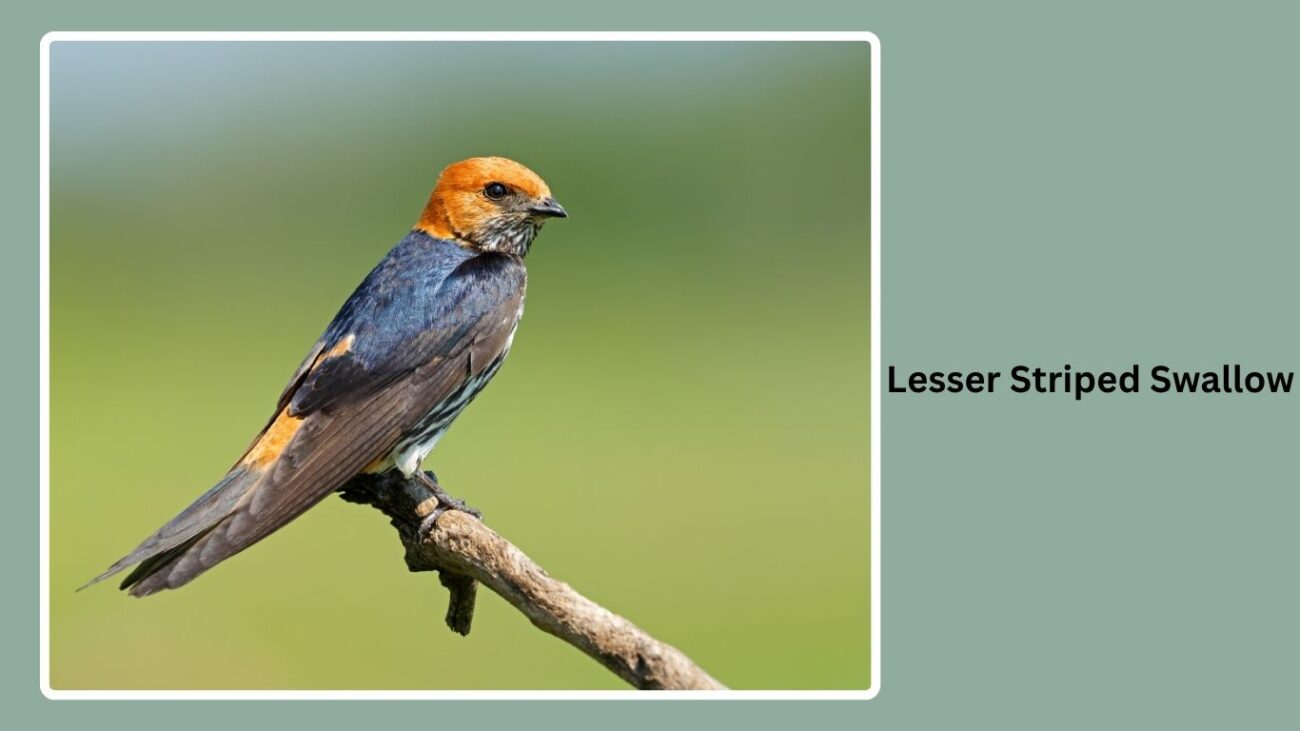
The Lesser Striped Swallow is a common and striking African swallow, notable for its bright rufous coloring and boldly streaked underparts. It’s widespread across sub-Saharan Africa.
Identification and Appearance
- Deep rufous crown and nape
- Glossy blue-black upperparts
- Creamy to buff underparts with bold dark streaks
- Long, forked tail
Habitat and Range
Found throughout sub-Saharan Africa in open woodlands, savannas, and human settlements.
Behavior and Diet
They catch insects while flying over open areas. These swallows often fly in pairs and may perch on wires or trees between feeding flights.
Nesting and Breeding
Builds mud nests under rock overhangs, eaves, or bridges. The nests are gourd-shaped with a side entrance, and birds often return to the same location year after year.
24. Greater Striped Swallow (Cecropis cucullata)
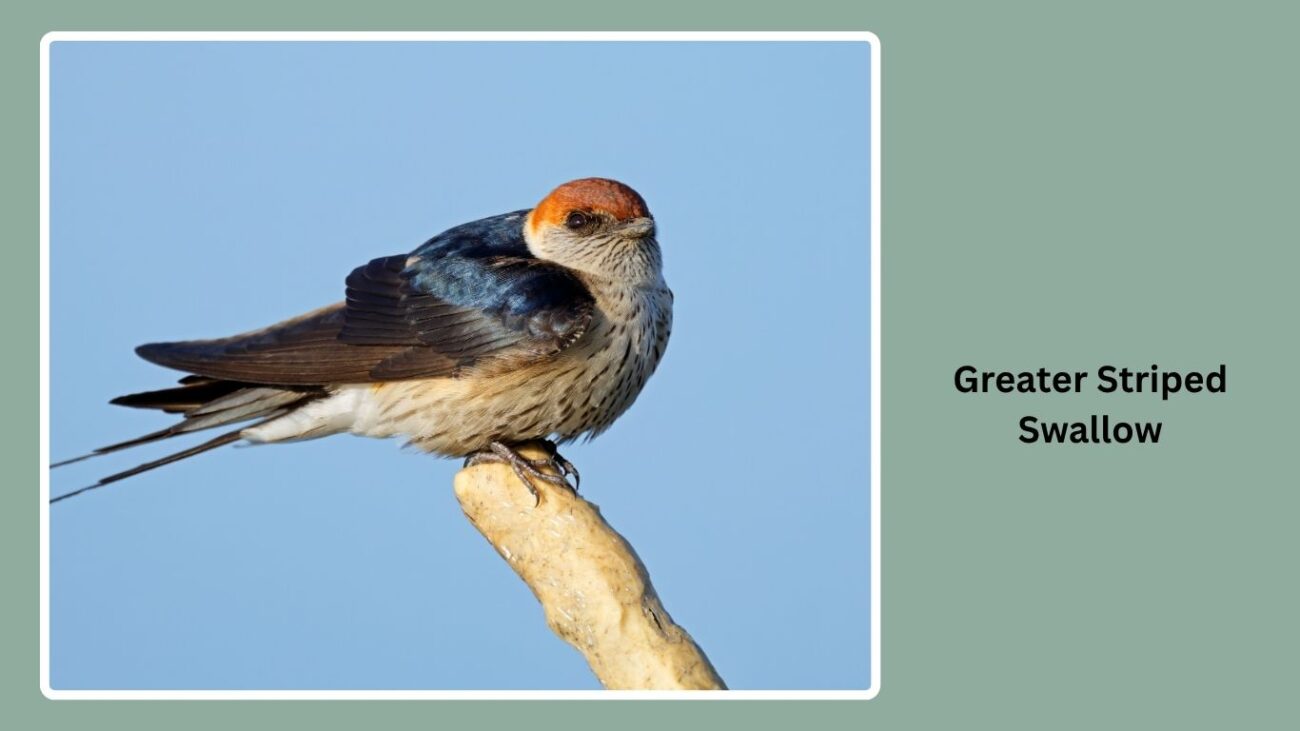
The Greater Striped Swallow is a large and boldly marked swallow native to southern Africa. It shares similarities with the Lesser Striped Swallow but is bigger and has longer tail streamers.
Identification and Appearance
- Reddish head and nape
- Glossy blue-black upperparts
- Buff to white underparts with fine dark streaks
- Long, deeply forked tail
Habitat and Range
Found mainly in South Africa, Lesotho, and parts of Namibia and Botswana. Prefers rocky hillsides, open woodlands, and manmade structures.
Behavior and Diet
Feeds on flying insects, captured in wide circular flights. Often seen gliding gracefully over open terrain and perching on wires or rocks.
Nesting and Breeding
They construct bottle-shaped mud nests on cliffs, under bridges, and on buildings. Nests have a long entrance tunnel and are reused year after year.
25. Mosque Swallow (Cecropis senegalensis)
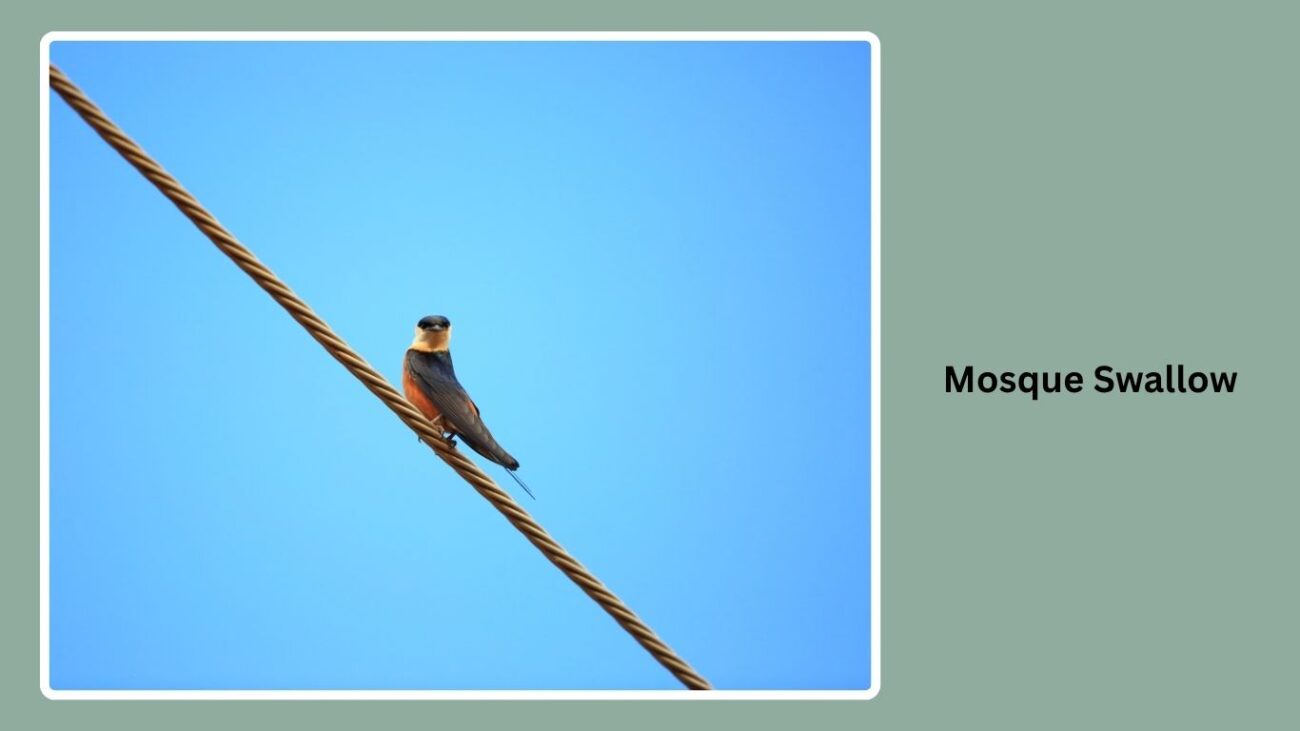
The Mosque Swallow is one of the largest swallows in Africa. It gets its name from its habit of nesting in large buildings, including mosques. This species is admired for its rich colors and powerful flight.
Identification and Appearance
- Chestnut forehead, crown, and nape
- Glossy blue-black upperparts
- Pale rufous to buff underparts
- Long tail with moderate fork
Habitat and Range
Widespread across tropical and subtropical Africa. Common in savannas, open woodlands, farmlands, and villages.
Behavior and Diet
Feeds on large flying insects while flying high and fast. Often seen soaring over open country and human settlements.
Nesting and Breeding
Builds large, mud nests with long tunnels under eaves, bridges, or cliffs. Pairs are often solitary nesters, though small groups may share suitable sites.
26. Rock Martin (Ptyonoprogne fuligula)
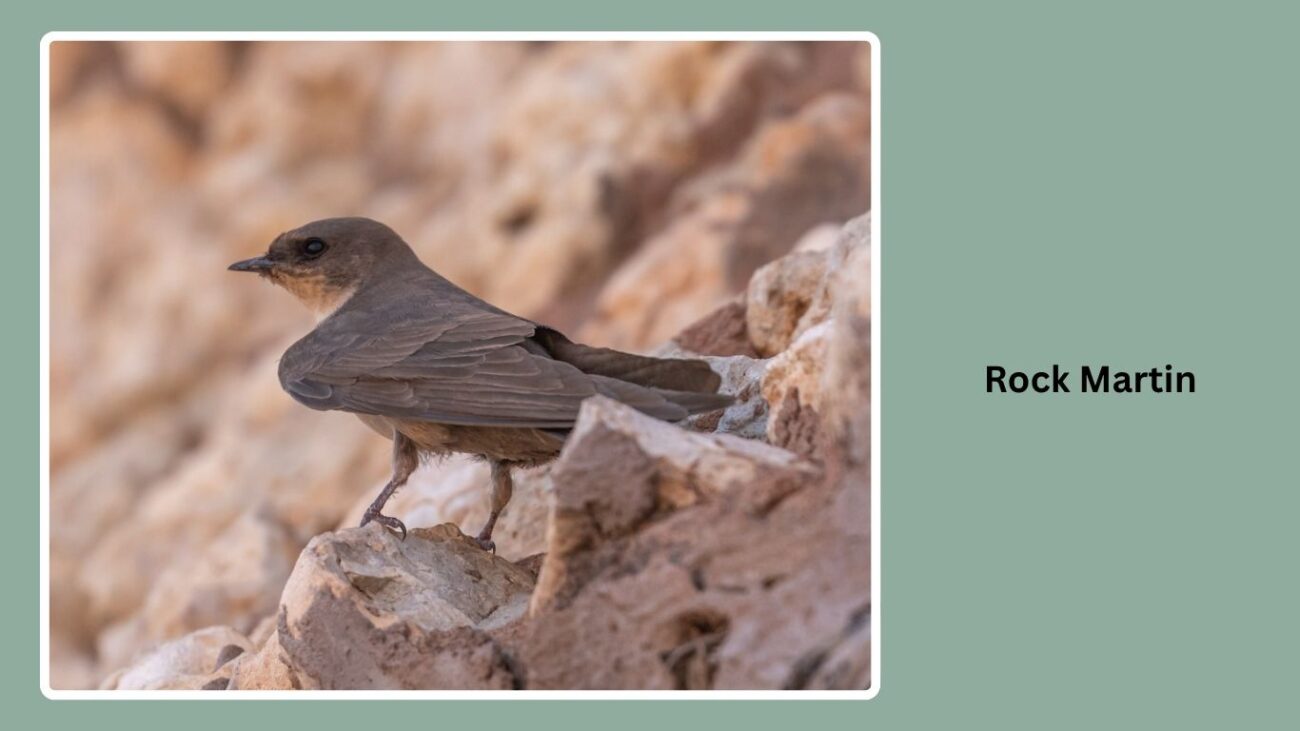
The Rock Martin is a dusky-colored swallow adapted to arid and rocky environments. Unlike many swallows, it doesn’t migrate and is often seen gliding near cliffs or buildings.
Identification and Appearance
- Plain brown upperparts
- Slightly paler underparts with faint streaking
- Short, square tail
- Subtle contrast in plumage, giving a uniform look
Habitat and Range
Found across southern and eastern Africa, often in mountainous areas, cliffs, quarries, and buildings.
Behavior and Diet
Feeds on flying insects caught during slow, buoyant flight close to rocky surfaces. Less social than other swallows, usually foraging alone or in pairs.
Nesting and Breeding
They build cup-shaped mud nests under ledges or on building walls. Nests are reused and repaired each season, typically in sheltered crevices.
27. Eurasian Crag Martin (Ptyonoprogne rupestris)
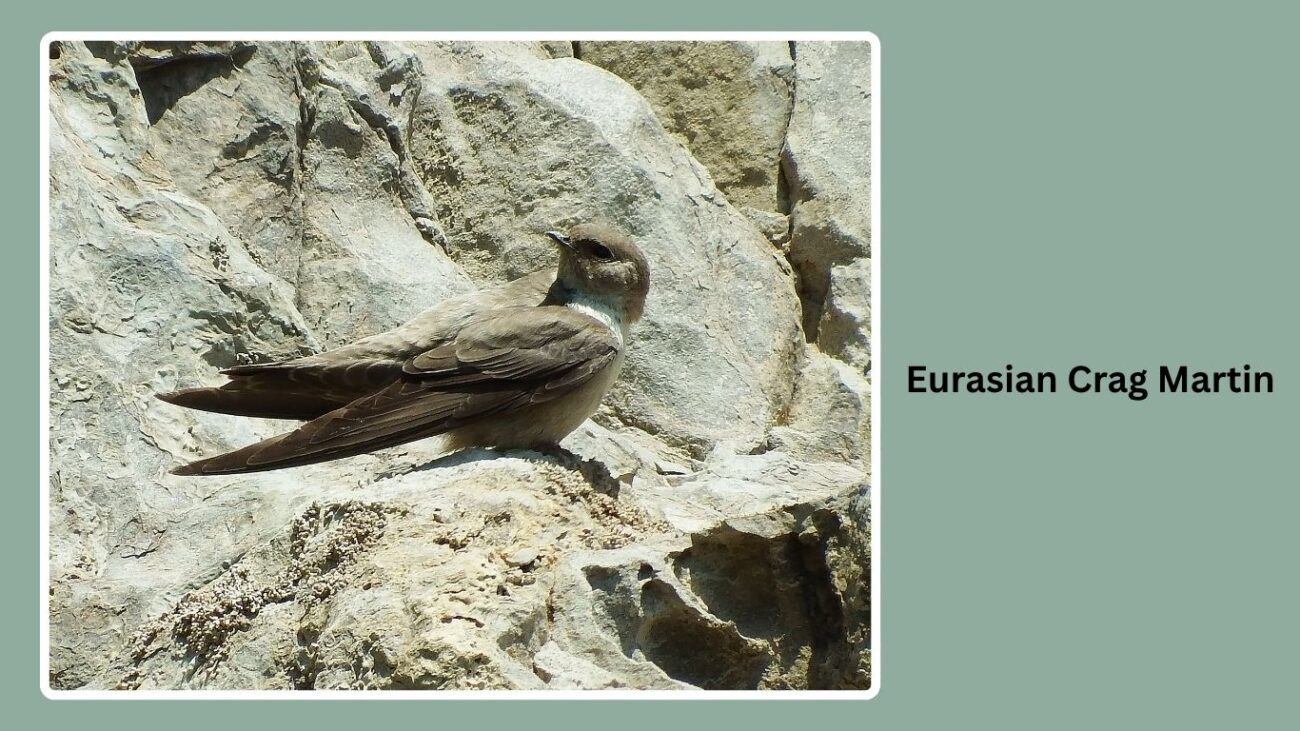
The Eurasian Crag Martin is a cliff-dwelling swallow native to southern Europe, North Africa, and parts of Asia. It’s known for its subtle coloring and cliffside nests.
Identification and Appearance
- Brown upperparts with slightly lighter underparts
- Slight dark spots on underwings
- Broad, square tail with small white patches
- Stocky build and strong wings
Habitat and Range
Found in mountainous and rocky regions across Europe and Asia. Also adapts to urban settings with tall buildings.
Behavior and Diet
Feeds on flying insects, often close to cliff faces or steep terrain. Its flight is slower and more fluttery than other swallows.
Nesting and Breeding
Builds open cup nests of mud under cliff overhangs, bridges, and building ledges. Nests are often placed on vertical surfaces and reused for many years.
28. Dusky Crag Martin (Ptyonoprogne concolor)

The Dusky Crag Martin is a non-migratory swallow native to South Asia. It’s closely related to the Eurasian Crag Martin but has a plainer appearance and favors similar cliffside habitats.
Identification and Appearance
- Uniform dark brown upper and underparts
- Slightly darker wings and tail
- Short, square tail with faint white tail spots
- Compact build and strong flight muscles
Habitat and Range
Found in India, Pakistan, Nepal, and surrounding regions. Common in rocky hills, cliffs, quarries, and man-made structures like forts and temples.
Behavior and Diet
Feeds on flying insects near rock faces, buildings, and open fields. Usually seen alone or in small groups with a slow, fluttering flight style.
Nesting and Breeding
Nests are mud-built cups placed under overhangs on cliffs or manmade walls. Birds often reuse nests, especially in traditional stone architecture.
29. Plain Martin (Riparia paludicola)
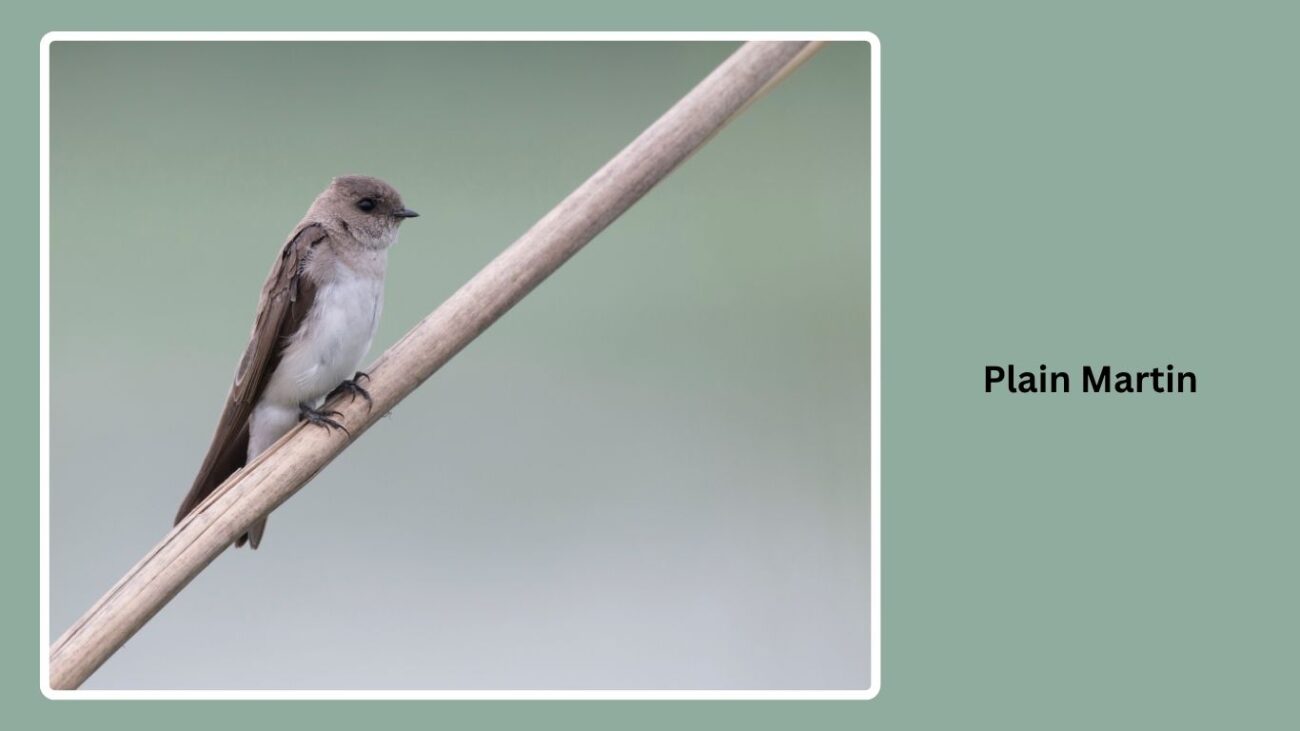
The Plain Martin, also called the Brown-throated Martin, is a widespread African swallow that lives near wetlands and open fields. It has a subdued appearance but is an efficient aerial hunter.
Identification and Appearance
- Dull brown upperparts
- Pale underparts with a faint brown chest band
- Small and stocky body
- Short, square tail
Habitat and Range
Common throughout sub-Saharan Africa, near rivers, lakes, marshes, and agricultural areas.
Behavior and Diet
Feeds on flying insects over water and open land. Its flight is low and direct. Usually found in loose colonies or scattered pairs.
Nesting and Breeding
Nests in burrows dug into sandy banks or vertical soil faces. These colonies may include dozens of nests close together. Nests are lined with grass, feathers, and other soft material.
30. Sand Martin (Riparia riparia)
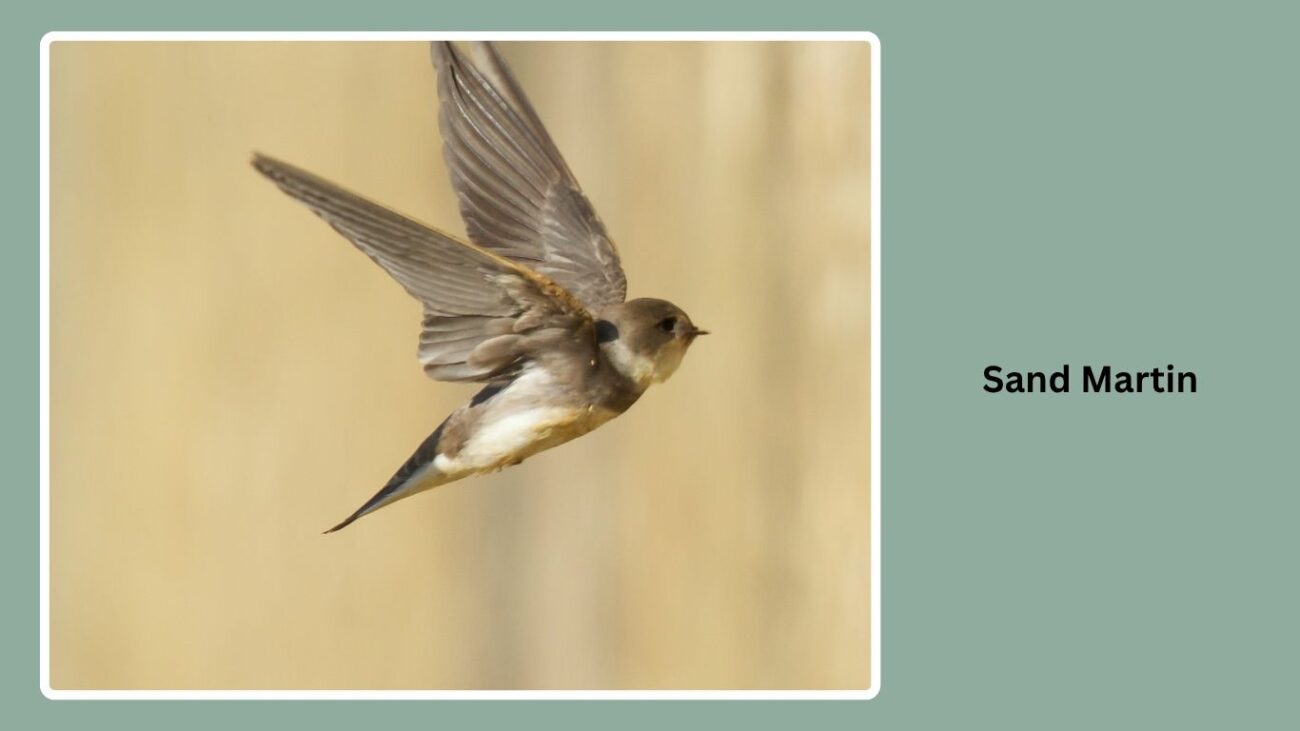
The Sand Martin—also known as the Bank Swallow in North America—is a small, energetic swallow that nests colonially in sandy riverbanks. It’s one of the most widespread swallow species across the Northern Hemisphere.
Identification and Appearance
- Brown upperparts
- White underparts with a distinct brown chest band
- Small size and slender build
- Short, slightly forked tail
Habitat and Range
Breeds across Europe, Asia, and North America. Prefers sandy riverbanks, cliffs, or man-made quarries near water for nesting.
Behavior and Diet
Feeds on tiny flying insects while in swift, agile flight. Often seen skimming over water bodies and open fields in groups.
Nesting and Breeding
Digs horizontal tunnels into sandy banks with a nesting chamber at the end. Colonies can include dozens to hundreds of pairs. Nests are lined with feathers and soft vegetation.
Summary:
Swallows are incredibly diverse, ranging from the familiar Barn Swallow to the lesser-known Dusky Crag Martin. Each species has unique markings, habitats, and nesting behaviors, yet all share the same elegant flight and aerial feeding habits. Whether they build mud nests under bridges or burrow into sandy banks, swallows are fascinating birds that thrive across regions and landscapes. This list gives bird lovers and nature enthusiasts a complete overview of 30 beautiful and important swallow species.

